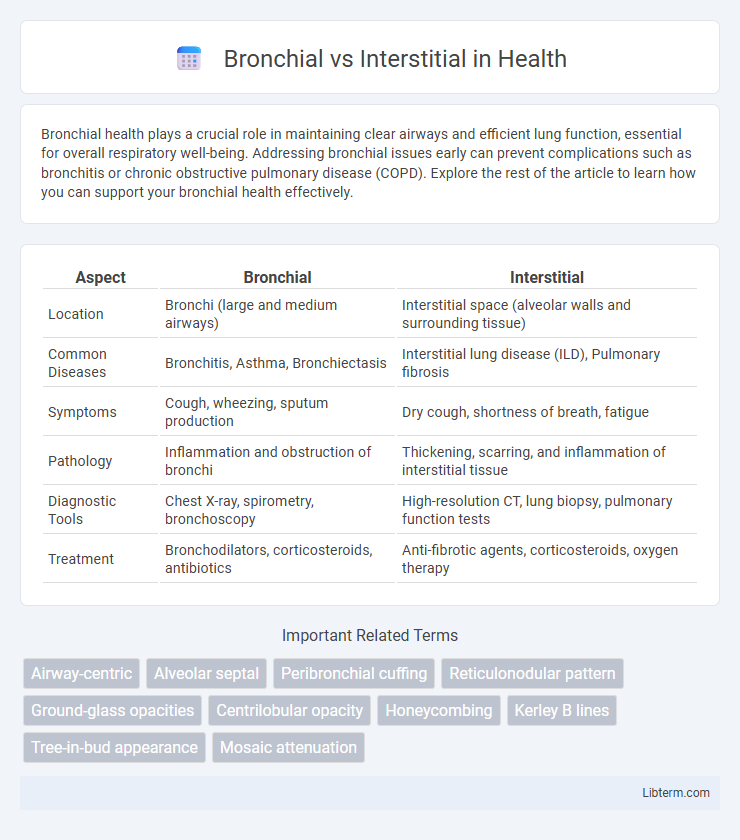Bronchial health plays a crucial role in maintaining clear airways and efficient lung function, essential for overall respiratory well-being. Addressing bronchial issues early can prevent complications such as bronchitis or chronic obstructive pulmonary disease (COPD). Explore the rest of the article to learn how you can support your bronchial health effectively.
Table of Comparison
| Aspect | Bronchial | Interstitial |
|---|---|---|
| Location | Bronchi (large and medium airways) | Interstitial space (alveolar walls and surrounding tissue) |
| Common Diseases | Bronchitis, Asthma, Bronchiectasis | Interstitial lung disease (ILD), Pulmonary fibrosis |
| Symptoms | Cough, wheezing, sputum production | Dry cough, shortness of breath, fatigue |
| Pathology | Inflammation and obstruction of bronchi | Thickening, scarring, and inflammation of interstitial tissue |
| Diagnostic Tools | Chest X-ray, spirometry, bronchoscopy | High-resolution CT, lung biopsy, pulmonary function tests |
| Treatment | Bronchodilators, corticosteroids, antibiotics | Anti-fibrotic agents, corticosteroids, oxygen therapy |
Understanding Bronchial and Interstitial Lung Diseases
Bronchial lung diseases primarily affect the airways, causing inflammation, obstruction, and symptoms like coughing and wheezing, as seen in conditions such as bronchitis and asthma. Interstitial lung diseases involve the lung interstitium, leading to fibrosis and impaired gas exchange, with idiopathic pulmonary fibrosis being a common example. Accurate diagnosis relies on clinical evaluation, imaging techniques like high-resolution CT scans, and pulmonary function tests to differentiate between airway and interstitial involvement.
Defining Bronchial Lung Disease
Bronchial lung disease primarily affects the bronchial tubes, causing inflammation, obstruction, and mucus production that impair airflow and oxygen exchange. In contrast, interstitial lung disease involves the lung's interstitium, the tissue surrounding alveoli, leading to scarring and stiffness that reduce lung elasticity and gas diffusion. Defining bronchial lung disease centers on its impact on the airways rather than the lung parenchyma, distinguishing it from interstitial lung conditions.
Defining Interstitial Lung Disease
Interstitial lung disease (ILD) refers to a diverse group of lung disorders characterized by inflammation and scarring of the interstitium, the tissue surrounding the air sacs (alveoli), which differs from bronchial diseases that primarily affect the airways. ILD leads to reduced lung elasticity and impaired gas exchange, contributing to symptoms like shortness of breath and chronic cough. Accurate diagnosis involves high-resolution CT scans and lung biopsies to identify patterns of fibrosis and inflammation specific to interstitial lung pathology.
Key Differences Between Bronchial and Interstitial Patterns
Bronchial patterns primarily involve the thickening and prominence of bronchial walls as seen on chest X-rays, indicating inflammation or infection like bronchitis or bronchopneumonia. Interstitial patterns reflect abnormalities in the lung interstitium, including fibrosis, edema, or infiltration, appearing as a reticular, nodular, or ground-glass opacity pattern on imaging. Key differences lie in the location and appearance: bronchial patterns highlight airway involvement with tubular or ring shadows, while interstitial patterns affect lung parenchyma with diffuse or patchy reticular changes.
Common Causes of Bronchial Diseases
Bronchial diseases primarily result from infections such as acute bronchitis caused by viruses like influenza and bacteria including Mycoplasma pneumoniae, as well as chronic conditions like asthma driven by allergens and chronic obstructive pulmonary disease (COPD) linked to long-term smoking exposure. Environmental pollutants, occupational irritants, and recurrent respiratory infections also significantly contribute to bronchial inflammation and airway obstruction. In contrast, interstitial lung diseases mainly involve the lung parenchyma and are often caused by autoimmune disorders, drug side effects, or exposure to fibrogenic agents like asbestos.
Common Causes of Interstitial Lung Disease
Interstitial lung disease (ILD) commonly results from causes such as idiopathic pulmonary fibrosis, hypersensitivity pneumonitis, connective tissue diseases like rheumatoid arthritis and systemic sclerosis, occupational exposures to asbestos or silica, and drug-induced lung injury from medications like amiodarone or methotrexate. Unlike bronchial diseases primarily affecting the airways, ILD targets the lung parenchyma and interstitium, leading to inflammation and fibrosis that impair gas exchange. Accurate diagnosis relies on clinical history, imaging with high-resolution CT scans, and sometimes lung biopsy to differentiate interstitial causes from bronchial pathology.
Clinical Symptoms: Bronchial vs Interstitial
Bronchial diseases typically present with clinical symptoms such as persistent cough, wheezing, and shortness of breath due to airway inflammation and obstruction. Interstitial lung diseases often manifest with progressive exertional dyspnea, dry cough, and bibasilar crackles resulting from fibrosis and alveolar involvement. Differentiating these symptom patterns is crucial for accurate diagnosis and targeted treatment strategies.
Diagnostic Approaches for Each Condition
Diagnostic approaches for bronchial conditions primarily involve spirometry to assess airflow limitation and bronchoscopy for direct visualization and sampling of airway secretions. Interstitial lung diseases require high-resolution computed tomography (HRCT) to identify characteristic patterns of lung fibrosis and lung biopsy for definitive histopathological diagnosis. Pulmonary function tests in interstitial disease often show restrictive patterns, contrasting with the obstructive patterns seen in bronchial disorders.
Treatment Modalities: Comparing Both Types
Treatment modalities for bronchial conditions primarily involve bronchodilators, corticosteroids, and targeted antibiotics to reduce airway inflammation and manage infections. Interstitial lung diseases require antifibrotic agents, immunosuppressants, and oxygen therapy to slow disease progression and improve lung function. Both conditions benefit from pulmonary rehabilitation, but treatment specificity depends on the underlying pathology and severity of airway versus interstitial involvement.
Prognosis and Long-Term Outcomes
Bronchial diseases, such as chronic bronchitis, often present with symptoms like persistent cough and mucus production, and generally have a more favorable prognosis with appropriate management and lifestyle modifications. Interstitial lung diseases (ILD), including idiopathic pulmonary fibrosis, typically result in progressive lung scarring that leads to reduced lung function and a poorer long-term prognosis, often requiring advanced therapies like antifibrotic agents or lung transplantation. Long-term outcomes for bronchial conditions tend to involve symptom control and prevention of exacerbations, whereas interstitial diseases frequently involve monitoring for disease progression and managing complications related to fibrosis.
Bronchial Infographic

 libterm.com
libterm.com